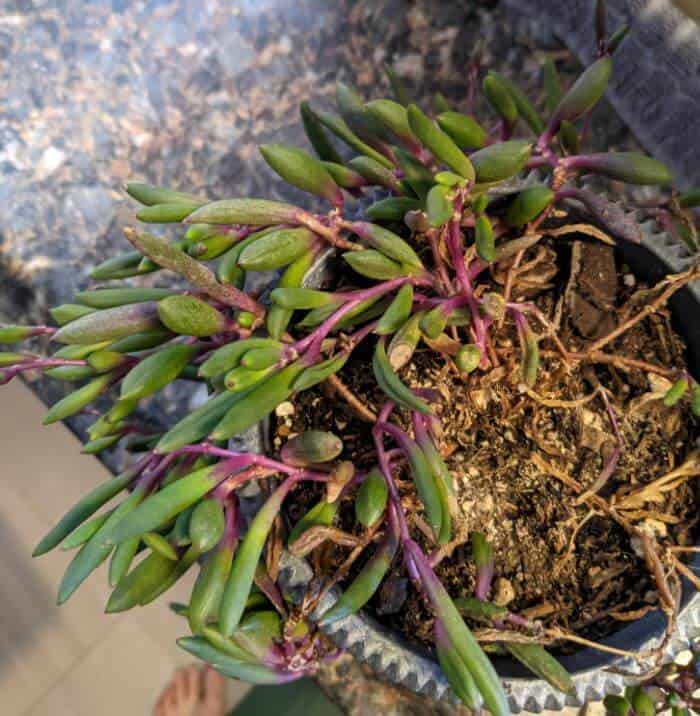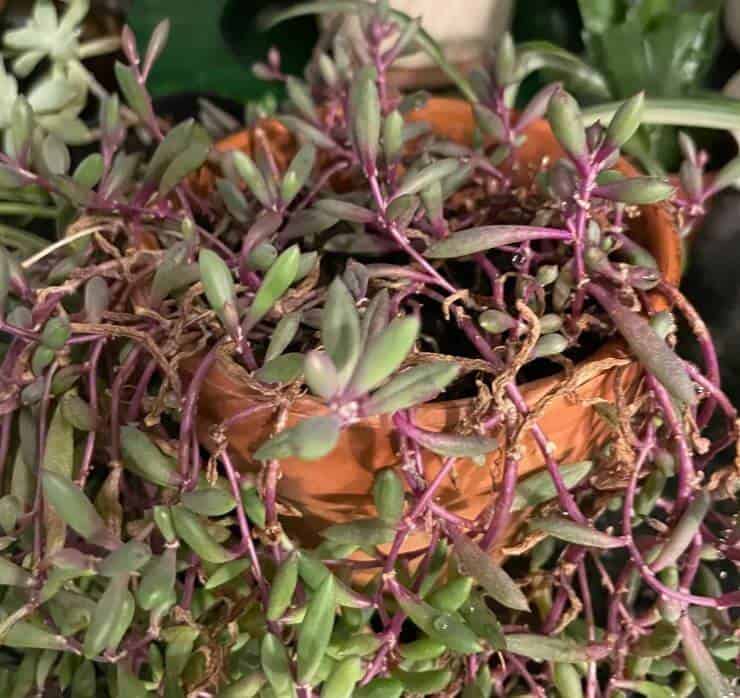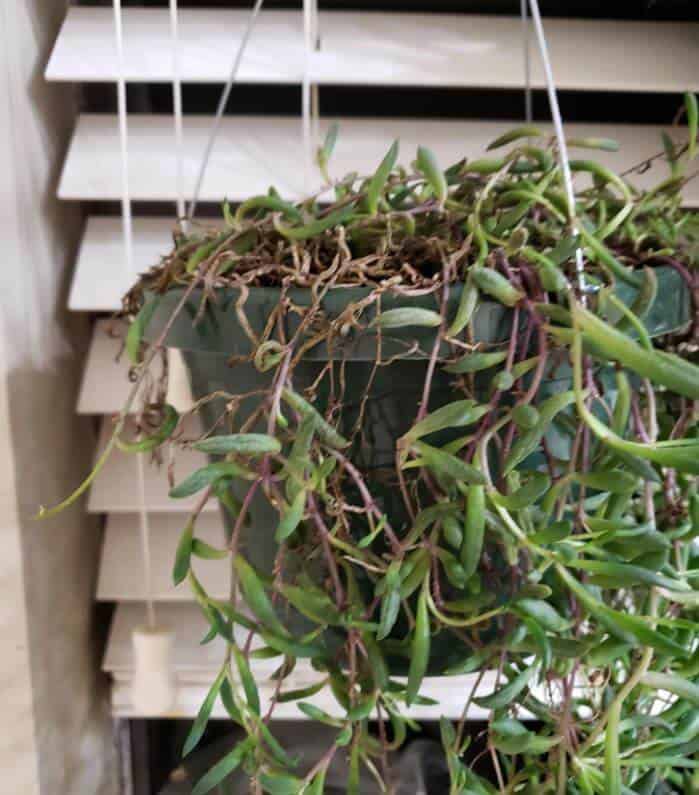Last Updated on July 3, 2023 by a Friendly Gardener
For fans of trailing succulents, the Ruby Necklace Succulent is a must to include in houseplant collections. Perfect for hanging baskets and rock gardens, the Othonna capensis may also be referred to as a ‘String of Pickles’. A great spilling or trailing plant, it boasts a rapid growth habit and will develop a reddish-purple stem when exposed to direct sunlight. Characteristic bean-shaped leaves and yellow blossoms resembling daisies add to this plant’s unique beauty. Ruby Necklace plants are natives of South Africa, hence their love of bright, full sun.
The Othonna capensis is adaptable to arid environments as they store water in foliage for dryer times. They can survive without water for quite a while. But like all houseplants, they, too, have issues and this plant has a unique habit. Its leaves will turn a bright red when the plant is stressed. But before you toss what appears to be a dying Ruby Necklace, consider what you can do to save your plant.
Symptoms Something Is Wrong

There are several signs that something is up with your Ruby Necklace, and these will generally appear long before your plant appears moribund.
- Yellowing leaves
- Red leaves
- Brown foliage
- Red spots
Yellowing and red leaves may simply appear because older leaves are being replaced by new growth. Or your plant may be reacting to overwatering or underwatering. Brown leaves generally indicate excessive watering or overfertilizing, while red spots can be caused by pest infestations.
Care and Environmental Issues

Light
As a lover of full sunlight, when provided with too little sun, it will become leggy because in search of a light source. Foliage will remain green. Provide your Ruby Necklace with generous amounts of full sun. If your home does not have sufficient natural light for this succulent, consider using grow lights.
Soil
Poorly draining soil can be fatal to a Ruby Necklace plant. This plant requires loose, well-draining, acidic potting soil. The ideal pH should measure between 6 and 6.5. Soils blended for cacti and succulents are ideal, or you can blend your own by adding lots of sand or perlite to the mix.
Water

As a drought-tolerant plant that stores its water reserves, the greatest threat to the Othonna capensis is overwatering. As a succulent, it is at risk for root rot. When you water, water deeply allowing all excess water to drain completely. Consider using a clay or terracotta pot to aid in wicking away excess moisture. Then let the soil bed dry out completely before watering again.
When the foliage begins to shrivel despite a regular watering schedule, you are probably overwatering. When the bean-shaped leaves absorb too much water, they can burst and will then turn mushy and start to shrivel.
Temperature
These succulents are not cold-weather creatures. They prefer warm climates and should never be exposed to temps that fall to 50°F. or below. Cultivating them indoors should not present any problems, although exposure to cold drafts will negatively affect them.
Feeding

Not a heavy feeder, the Ruby Necklace does not require feeding. If you want to sustain new growth, use a low-nitrogen liquid fertilizer twice during the growing season. Excessive fertilization can lead to salt buildup in the soil and brown foliage. If you suspect overfeeding is to blame for your plant’s poor appearance or browning leaves. Flush the soil bed out thoroughly, making sure that excess water drains entirely.
Pests and Diseases
Pest Infestations
Just like many other houseplants, the Ruby Necklace can become a target for pests looking to take up residence. Scales, mealybugs, fungus gnats, caterpillars, and spider mites will gladly make their homes in the foliage of this plant. Examine your plant regularly for signs of webbing, white cotton-like deposits, small hard dark brown lumps, or gnats flying around your plant. These are telltale signs that your plant is infested.
What to Do
Consider removing caterpillars, mealybugs (white cottony deposits), and scale bugs (dark brown hard lumps) manually. Spider mites can be removed with a jet spray of water. Then treat your Ruby Necklace plant with insecticidal soap or with organic neem oil. Remember to reapply the treatment until all signs of pest infestations have been eliminated. Pay close attention to your plant if your spot caterpillars in the summer and fall, as they can destroy this plant quite quickly.
Basil Stem Rot
This is a common disease that strikes Ruby Necklace plants and develops because of overwatering. Remember that your Ruby Necklace plant is a succulent, so it stores water in foliage for drought-like conditions. So, leaving this plant standing in soggy soil will create the ideal environment for basil stem rot as well as other fungal infections to attack your plant.
What to Do
Let the soil bed dry out between waterings and make sure to reduce watering in the wintertime. Touch the soil bed before watering. If it feels moist or damp, wait a few more days before giving your plant a drink.
Leaf Scorch
Leaf scorch is another common affliction for Ruby Necklace plants and may lead to the appearance of your Ruby Necklace Succulent dying. It occurs when your plant has lost too much water from its foliage either because it has been neglected or subjected to prolonged drought. Leaves turn brown and dry, eventually dying.
What to Do
Your first instinct may be to drown your plant in water, but you should not. Prune affected stems and begin giving very small doses of water until your plant perks up. Take care not to render soil soggy.
Leaf Spot Disease
In the case of the Othonna capensis, Leaf Spot disease can be caused by excess amounts of iron in the soil bed, overwatering, underwatering, or fertilization with excessive amounts of nitrogen.
What to Do
When Ruby Necklace foliage turns brown and green spots appear, reduce watering significantly and avoid using a fertilizer that is high in nitrogen.
When All Appears to Be Lost

When your plant appears to be dying, your best bet is to ‘chop and prop’ or prune and propagate using stem cuttings. Take a healthy cutting with two or three nodes on it. Place the cutting directly on the soil or in a transparent water jar or vase. Soil propagation is less at risk of rotting. Keep the soil moist but not soggy and wait for signs of new growth from your new Ruby Necklace plant.

